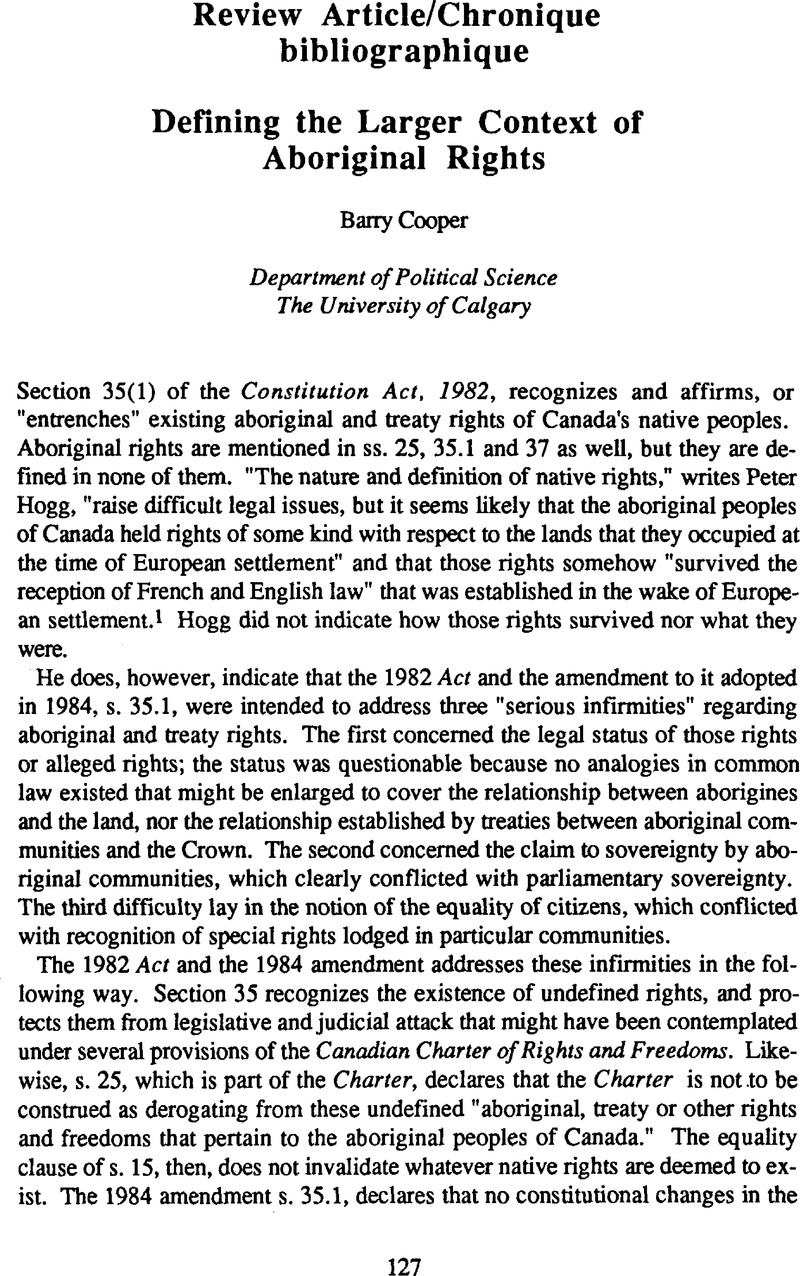No CrossRef data available.
Published online by Cambridge University Press: 18 July 2014

1. Hogg, Peter W., Constitutional Law of Canada (2nd ed.; Toronto: Carswell, 1985), 563–568Google Scholar.
2. Green, L.C. and Dickason, Olive P., The Law of Nations and the New World, with an Introduction by Christian, Timothy J. (Edmonton: The University of Alberta Press, 1989)Google Scholar. This handsomely produced book consists of two related essays, Green's “Claims to Territory in Colonial America” (1-139), and Dickason's “Concepts of Sovereignty at the Time of First Contact” (141-285). Christian's Introduction precedes Green's chapter. There is a barely adequate index.
3. For purposes of this review, aboriginal peoples will also be identified as Amerindians and as nomads, terms current at the time of their early contact with Europeans. Europeans also identified aboriginal peoples as barbarians and savages and themselves as civilized. The former terms have clearly become invidious; Europeans, however, may still be identified as “civilized” in the strict sense of having come from an urban culture. Some such distinction is required in order to indicate, among other things, the differences in military capacity of the several “civilizations” (in the wider sense) involved in the contact between European and American natives. Precise distinctions are required in order to bring to light spiritual as well as political, legal and military differences between the inhabitants of Europe and the New World, though no moral weight should be accorded the terminology used here.
4. Green, and Dickason, , The Law of Nations and the New World, 3Google Scholar.
5. Ibid., 3.
6. The text is translated in Dawson, C. (ed.), Mission to Asia (New York: Harper, 1966), 85–86Google Scholar; see also the commentary by Voegelin, E., “The Mongol Orders of Submission to European Powers,” Byzantion, 11 (1941), 378–413Google Scholar.
7. Dawson, , Mission to Asia, 84–85Google Scholar.
8. John 18: 34.
9. Wheaton, Henry, Elements of International Law, edited by Dana, R.H. (Boston: Little, Brown, 1866), sec. 38Google Scholar.
10. Green, and Dickason, , The Law of Nations and the New World, 175Google Scholar.
11. Ibid., 184.
12. Aristotle, , Politics, 1254b15Google Scholar.
13. I Tim. 6.
14. Green, and Dickason, , The Law of Nations and the New World, 202Google Scholar.
15. S.T., I-II, q. 91, 2.
16. Green, and Dickason, , The Law of Nations and the New World, 214Google Scholar.
17. See Flanagan, Thomas, “The Agricultural Argument and Original Appropriation: Indian Lands and Political Philosophy,” Canadian Journal of Political Science 22 (1989), 589–602CrossRefGoogle Scholar, and references.
18. Green, and Dickason, , The Law of Nations and the New World, 236Google Scholar.
19. Ibid., 241.
20. Ibid., 248.
21. Ibid., 248-249.
22. Ibid., 249.
23. Ibid., 249.
24. Flanagan, Thomas, “Francisco de Vitoria and the Meaning of Aboriginal Rights,” Queen's Quarterly, 95 (1988), 430Google Scholar.
25. Ibid., 430.